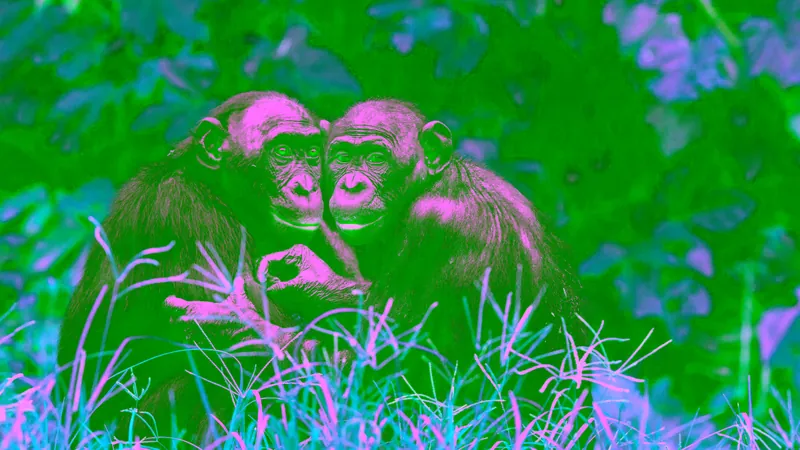
Bonobos’ Rich Communication Reveals Unprecedented Complexity in Animal Language!
2025-04-03
Author: William
Bonobos’ Rich Communication Reveals Unprecedented Complexity in Animal Language!
In an extraordinary breakthrough, researchers have revealed that bonobos, the highly intelligent great apes found in the Republic of Congo, may possess one of the closest forms of animal communication to what we understand as language. A team of Swiss scientists, led by evolutionary anthropologist Melissa Berthet from the University of Zurich, has demonstrated that bonobos can combine a variety of vocalizations—such as peeps, hoots, yelps, grunts, and whistles—into complex meanings that transcend simple individual sounds. This remarkable ability, referred to as non-trivial compositionality, was once believed to be a unique trait of human language.
To investigate this phenomenon, Berthet and her team constructed a comprehensive database of 700 different bonobo calls, analyzing them using sophisticated techniques borrowed from the field of distributional semantics. This approach, traditionally used to decode extinct languages like Etruscan, allowed researchers to gain fresh insights into the meanings behind bonobos' vocalizations in their natural habitat.
A Deep Dive into Bonobo Communication
The study emphasized the importance of context in understanding these vocalizations. For instance, grunts—used in various situations like feeding or grooming—are interpreted as a call for attention, akin to saying "look at me." Yelps convey an imperative "let’s do this," while lower hoots express excitement. High hoots serve as a signal for alerting others to danger or indicating one's location, and whistles are intended to keep the group together.
Berthet’s team also identified several intriguing combinations of sounds, revealing a level of complexity previously thought exclusive to humans. For example, a high hoot followed by a low hoot functions as a distress call, capable of not only signaling alarm but also curtailing dominant displays amongst other bonobos. Moreover, interactions for romantic encounters were deciphered through combinations of "I would like to" peeps followed by "let’s stay together" whistles, showcasing their rich social behaviors.
The Future of Animal Communication Research
This pioneering work has opened up new avenues not only for understanding bonobos but also for uncovering the depths of communication across various animal species. Berthet expressed enthusiasm for future studies: “We now have a robust methodology for exploring compositionality and meaning, and I aim to extend this research to other primates like chimpanzees, gibbons, and gorillas.” Such studies could help trace the evolution of these abilities and reveal whether non-trivial compositionality is a rare occurrence or commonplace among great apes.
Interestingly, there are many more layers to explore regarding bonobo communication. Researchers note the potential significance of unobtrusive gestures that often accompany vocalizations. These gestures might refine or even alter the meanings of their calls, suggesting that our current understanding of bonobo communication could still be merely scratching the surface.
As we delve deeper into the world of bonobo linguistics, one thing becomes abundantly clear: the line between human and animal communication may be blurrier than we ever imagined. The implications of this research could revolutionize how we perceive animal cognition and communication, urging us to reconsider our own understanding of language. The exciting quest to decode animal languages has just begun, and who knows what we’ll discover next? Stay tuned for updates as science uncovers the mysteries of the animal kingdom!









 Brasil (PT)
Brasil (PT)
 Canada (EN)
Canada (EN)
 Chile (ES)
Chile (ES)
 Česko (CS)
Česko (CS)
 대한민국 (KO)
대한민국 (KO)
 España (ES)
España (ES)
 France (FR)
France (FR)
 Hong Kong (EN)
Hong Kong (EN)
 Italia (IT)
Italia (IT)
 日本 (JA)
日本 (JA)
 Magyarország (HU)
Magyarország (HU)
 Norge (NO)
Norge (NO)
 Polska (PL)
Polska (PL)
 Schweiz (DE)
Schweiz (DE)
 Singapore (EN)
Singapore (EN)
 Sverige (SV)
Sverige (SV)
 Suomi (FI)
Suomi (FI)
 Türkiye (TR)
Türkiye (TR)
 الإمارات العربية المتحدة (AR)
الإمارات العربية المتحدة (AR)